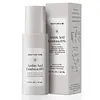What's inside
What's inside
 Key Ingredients
Key Ingredients

 Benefits
Benefits

 Concerns
Concerns

No concerns
 Ingredients Side-by-side
Ingredients Side-by-side

Water
Skin ConditioningAzelaic Acid
BufferingButylene Glycol
HumectantC12-15 Alkyl Benzoate
AntimicrobialGlycerin
HumectantCaprylic/Capric Triglyceride
MaskingMethylpropanediol
SolventPentylene Glycol
Skin ConditioningIsostearyl Alcohol
EmollientC13-15 Alkane
SolventEthylhexyl Olivate
Skin ConditioningButylene Glycol Cocoate
EmulsifyingNiacinamide
SmoothingAllantoin
Skin ConditioningSebacic Acid
BufferingAcetyl Rheum Rhaponticum Root Extract
BleachingAstrocaryum Murumuru Seed Butter
EmollientGossypium Herbaceum Seed Oil
Skin ConditioningBidens Pilosa Extract
HumectantLinum Usitatissimum Seed Oil
PerfumingAvena Sativa Kernel Extract
AbrasiveCarbomer
Emulsion StabilisingHydroxyacetophenone
AntioxidantSilica
AbrasiveBenzyl Alcohol
PerfumingPanthenyl Triacetate
Xanthan Gum
EmulsifyingSodium Hydroxide
BufferingEthylcellulose
Squalane
EmollientEthylhexylglycerin
Skin ConditioningLactobacillus Ferment
Skin ConditioningSodium Benzoate
MaskingPotassium Sorbate
PreservativeTocopherol
AntioxidantWater, Azelaic Acid, Butylene Glycol, C12-15 Alkyl Benzoate, Glycerin, Caprylic/Capric Triglyceride, Methylpropanediol, Pentylene Glycol, Isostearyl Alcohol, C13-15 Alkane, Ethylhexyl Olivate, Butylene Glycol Cocoate, Niacinamide, Allantoin, Sebacic Acid, Acetyl Rheum Rhaponticum Root Extract, Astrocaryum Murumuru Seed Butter, Gossypium Herbaceum Seed Oil, Bidens Pilosa Extract, Linum Usitatissimum Seed Oil, Avena Sativa Kernel Extract, Carbomer, Hydroxyacetophenone, Silica, Benzyl Alcohol, Panthenyl Triacetate, Xanthan Gum, Sodium Hydroxide, Ethylcellulose, Squalane, Ethylhexylglycerin, Lactobacillus Ferment, Sodium Benzoate, Potassium Sorbate, Tocopherol
 Reviews
Reviews

Alternatives
Ingredients Explained
These ingredients are found in both products.
Ingredients higher up in an ingredient list are typically present in a larger amount.
Azelaic acid is a multitasker ingredient that helps treat acne, pigmentation, and irritation. It is a great option for sensitive skin.
What makes azelaic special?
The best thing about azelaic acid is it's gentleness. It's generally well-tolerated and safe to use alongside other actives like niacinamide or salicylic acid.
Unlike AHAs, azelaic acid will not make you photosensitive/sun sensitive.
You can find this ingredient naturally occurring in grains like wheat, rye, and barley. In cosmetics, azelaic acid is typically lab-made, which is more stable and effective.
Learn more about Azelaic Acid